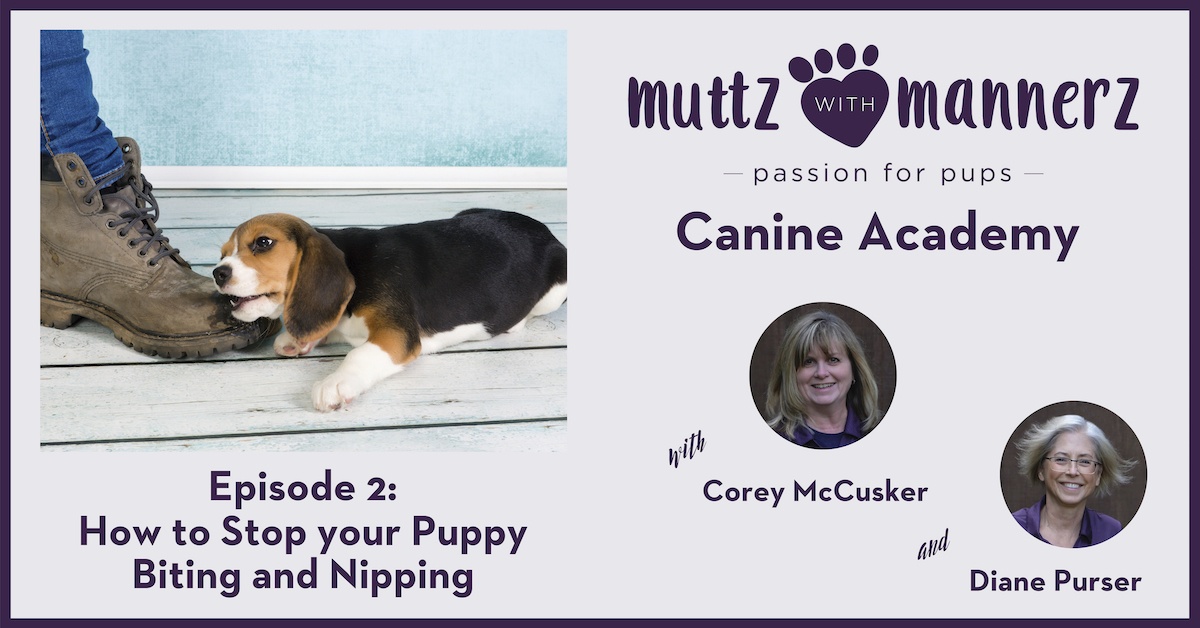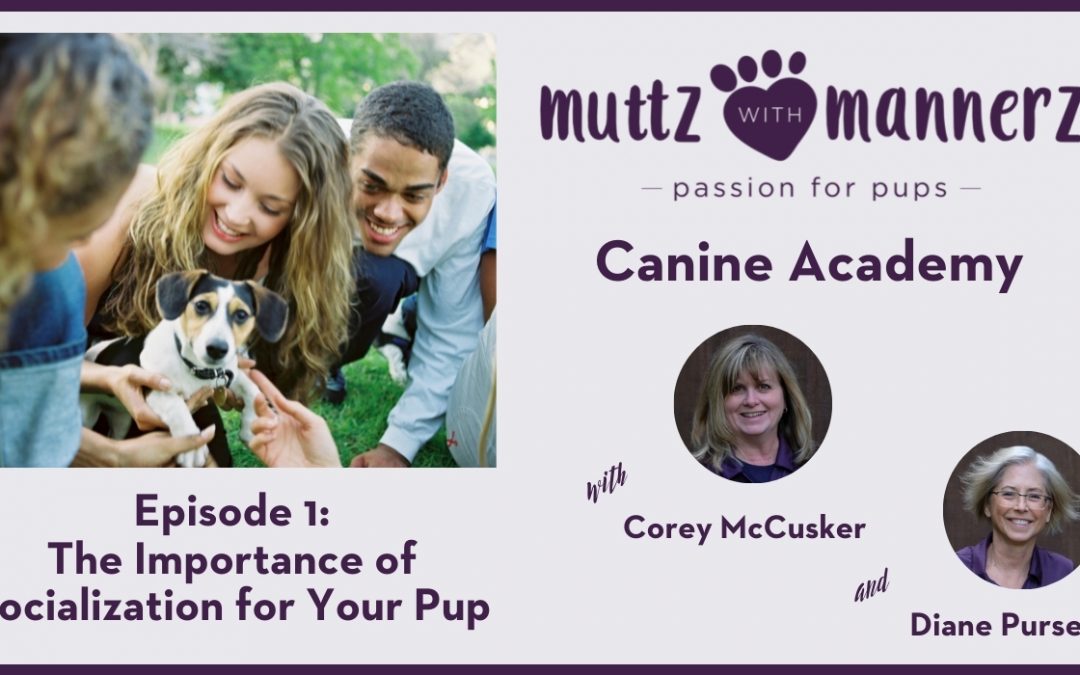
Corey McCusker 00:03
Hello dog lovers, and welcome to Muttz with Mannerz Canine Academy Podcast, where we’ll share dog training tips and educational information to help you raise your pup -young or old – so they can be a loving part of your family and your community for life. I’m your host, Corey McCusker, Canine Coach, along with Diane Purser, Canine Educator. We have a passion for pups and we thank you for joining us today.
Diane Purser 00:31
Hi, everyone, Diane here. So today’s topic is puppy biting and nipping. A concern for most new puppy owners. Corey is going to be talking in a few minutes, and giving you three steps to help you manage this with your pup. But to start, I just wanted to mention that it’s a natural behavior for puppies to bite and nip. As soon as you get them, you will notice very quickly, if you haven’t already, that your puppy mouths or nips and bites just about anything or anyone it comes in contact with.
This is a very natural behavior. Your puppy is exploring the big new world that you’ve brought them into, and it’s their natural way to play and communicate with other puppies. However, as we know, puppy teeth are razor sharp and will become adult teeth very soon. So it’s really important that your puppy learns to use their mouth and teeth gently. A natural response we all have is as soon as you are on the receiving end of those sharp little teeth, is to stop the behavior. No one wants a dog that could bite and cause damage to a person or another dog. So it’s important to ensure that your puppy learns properly, what’s an acceptable behavior. Corey, can you touch on this and how to deal with it?
Corey McCusker 01:56
Sure, Diane. Before we get into the tips, I want to talk about a term that is called bite inhibition. So what is bite inhibition? Bite inhibition refers to a dog’s ability to control the force of his mouthing. A puppy or dog who hasn’t learned bite inhibition with people doesn’t recognize the sensitivity of human skin. And so they bite too hard when playing. Puppies usually learn bite inhibition during play with other puppies. Let me just give you a couple of examples so that we can talk about how a puppy learns to use their mouth.
So think about a Labrador Retriever. A Lab Retriever – who may be is a hunting dog and retrieving birds for their handler – will go and pick up that bird, but not puncture it. It will pick it up not to hurt it and bring it back to the handler. It learns the pressure point of the mouth.
Another example, if you think of a police dog. So, say there was a police dog, a German Shepherd, that was taught how to go and capture or hold on to a criminal that’s running away. That Shepherd is taught how to put their mouth on it, but not to a point that it punctures the skin. It’s to hold and grab. So those are just two examples of dogs, how they’re learning how to use the pressure of their mouth.
So you might not have a dog that’s retrieving birds or criminals, you may just have a puppy that wants to play. It’s important for us to teach them how to play with humans. So I want to go through three steps to help you guide your puppy to create bite inhibition. So step one; we’re going to teach the puppy how to use their mouth gently. One of the key benefits of a puppy staying with its mom and littermates until at least the eight weeks age – no sooner – is that during those eight weeks, it will develop how to play and it goes through a process naturally. If a puppy nips a litter mate too hard, the other pup usually will yelp or stop playing. This lets the pup know that the bite was too hard. Sometimes the mom will even intervene if the puppy is playing too rough. When you play with your puppy, you have to realize you’re just another pup to them. So they will mouth you just the same as they would their litter mates until they are told it hurts. So if and when your puppy does bite, you should give a little yelp or say, ‘ouch!’, in a serious tone. What you’re really doing there is you’re mimicking another pup. You’re speaking their language. This should make them back off and reconsider what just happened. If they do start nipping again, yelp or say ouch again, and then move away. Pay no attention to them and stop playing for a few minutes. Maybe you have a baby gate up that you can step over to remove yourself, or maybe step behind a door. Repeat this process of yelping or saying ouch and moving away if the puppy is biting too much. What you are doing by moving away is you’re teaching them that they lose your attention. They don’t get to play with you because they’re nipping too hard. The next step we want to do is, we want to reduce the frequency of the biting. So now you’ve trained your pup to use their mouth gently, they understand if you yelp they’ll move away. What’s next? It’s still important to reduce the frequency of this behavior. For me, I want to completely stop them from mouthing humans. Your puppy is soon going to be growing up and turning into an adult dog. Any type of biting as an adult, even in play, can be very scary for people, especially kids, and also other dogs. It’s not only scary, it can be really harmful and hurt. The most common command – and I work with this a lot with puppies – that you’re going to teach is the “leave it” command.
What does “leave it” mean? “Leave it” means no touch on human, toy, food. “Leave it. Don’t touch it.” So how do you do this? What I want you to do is, you take a treat and you place it in the palm of your hand. I want you to put the palm of your hand with the treat in it close to the dog’s nose, and then close your hand quickly. So they know the treat is in there. What they’re going to try to do is get to that treat. And how are they going to do that? They’ll poke at your hand, they may be nip at your hand, nudging at your hand. When the puppy stops nudging or nipping, maybe they’ll look away, that’s when you reward them. What you do is you open the hand and say, “Take it,” or, “Okay,” and give them permission. So you do this a number of times till they understand when you say, “Leave it”, they’ll back off, not touching it, and then they get that reward. So when they know the “leave it” command and understand it, when they’re given that command, they won’t touch the human or the garbage, the toy or the tree. Whatever it is that they’re going for. So this command, “leave it”, can actually help with this biting and nipping and it stops them from going at the human – or child – to play and bite. No mouth on us. The last step is redirecting their biting. There are going to be times when it’s okay for your puppy to use a stronger bite. But once again, your puppy needs to be taught when this is okay.
For example, think about when they’re playing. It’s going to be okay for them to bite one of their toys. Particularly when your puppy is young, the desire to play – because they get so crazy and just want to go, go, go – it can all go out the door. So we’ve talked about step one and two. Everything goes out the door. So what we need to do is when that overstimulation happens during the play, and we don’t want their mouth on us, we’ll bring a toy into it and redirect them so the mouth goes on to the toy. This stops them from biting us, and chewing on an appropriate toy. I do want to touch also on the teething stage. Because, the teething stage is when they’re about four and a half months. What will happen is they’re going to need those really good durable chew things because their teeth are falling out, the new teeth are growing and their mouth is going to be really irritated. So that time is when you’re going to really want to bring those toys in.
Diane Purser 08:26
Ah, yes, teething. I remember that so well. It’s not popular with anybody. And the sooner you can help them through that period, the better. You mentioned just a moment ago about overstimulation. And one of the things that’s an important part of basic puppy training, and also helps with puppy biting, is crate training. If you think of a toddler, and what they’re like – if they don’t get their naps and how irritated they can get or how they don’t listen to you, or they get very angry – well your puppy can be similar if it doesn’t get enough quiet time or sleep. Their excited state can make it difficult for you to get their attention, or for them to remember what you have taught them, just like you mentioned before. But they can’t help themselves. They’re just puppies and they’re just learning. So before the excitement escalates too far, gently and patiently guide them to their crate for a rest. This will also help to minimize the biting and nipping.
Corey McCusker 09:29
It’s so true. This is why I’m such a big believer in crate training because they really do need to learn how to settle themselves. So this brings us to the end of our podcast, and we’ve discussed a number of things about nipping and biting. Diane touched on that it’s a natural behavior. They’re going to do it. It’s part of puppyhood. I touched on the bite inhibition and the three steps to guide them through teaching them to use their mouth gently, reducing that frequency of biting by removing yourself, and then just using toys and that to redirect. Also remember that the leash is your friend during this training time and you can have them on leash in the house to control them if you need to. And we know you’re not alone. We have been puppy owners. We have dealt with the puppy nipping and biting. So we share your pain and frustration, but we know that it’s just a stage that they’re getting to go through. So it’s really a time that you have to be patient. You have to definitely supervise if you have kids. And remember that four and a half month teething time. It will get better and it will improve. You just have to be consistent and persistent.
We want to thank you for joining us today and listening to our Muttz with Mannerz Canine Academy Podcast on nipping and biting. We hope that you found this information helpful. If you would like more details, visit our website www.muttzwithmannerz.com. The link to our blogs on nipping and biting, and crate training are available for you in the show notes. If you have questions or ideas for future podcasts, email me at corey@muttzwithmannerz.com. Join us for other episodes. We’d also love if you would rate, review or share this with other canine lovers. We look forward to seeing you next time.
Diane Purser 11:24
Bye everyone.

